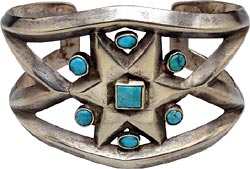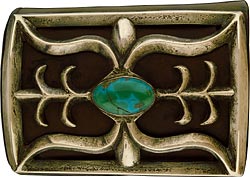
About 1930
Cast silver with turquoise on a leather band
Bequest of Virginia Doneghy
|
The Navajo
The Navajo call themselves Diné (DEE-nay), meaning "the people." They migrated from northwestern Canada sometime
around 1400 to what is now the southwest region of the United States. The early Navajo were nomadic hunters. They learned farming and
weaving from the native Pueblo peoples, with whom they also developed trade networks.
Since the 16th century, various peoples, including the Spanish, Mexicans, and Euro-Americans, tried to control the Navajo. But their sophisticated
native culture remained strong. The United States Army began an aggressive campaign against the Navajo in 1863, destroying their livestock
and crops. Many Navajo were then forced onto government reservations. |

|
Bracelet
before 1925
Silver, turquoise
Bequest of Virginia Doneghy |
Silver
While on the reservation, many Navajo artists created silver jewelry and textiles for trade. When white traders opened trading posts
on the reservations, a barter system developed, enabling the Navajo to exchange their handmade products for tools, canned foods, and other
manufactured products. Silver jewelry was a particularly valuable trade item, especially by the turn of the century, when railroad
expansion brought a flourishing tourist market to the Southwest. Commercial jewelry businesses coerced Navajo artists to mass-produce
nontraditional objects such as boxes, letter openers, and ashtrays.1 However, silversmiths who lived outside of large trade centers
continued to produce more traditional art forms, including bracelets, buckles, and ketohs.
Ketohs
Ketohs were originally leather straps worn by Navajo archers to protect their forearms from the snap of the bowstring when shooting
an arrow. By the 1870s, silver was commonly attached to the leather to give the wearer more protection. The designs of the silver ketohs
gradually became more intricate as they evolved into the purely decorative form of jewelry they are today. In the reservation barter
system, a ketoh could be traded for several sheep.2

|
Rollover the image to see details from the Ketoh Wrist Guard |
Ketoh
This ketoh features an open-worked rectangle of silver attached to a dark brown leather strap. An oval of
INLAID turquoise marks the
center of the piece. Broad curves of silver, like pairs of leaves around a central bud, extend to the four corners of the design. Single
corn stalks emerge from the top and bottom of the turquoise.
Ketoh designs often have an emphatic center like this one, recalling the sacred place from which the first Navajo emerged from the giant reed
into this world. The symmetrical four-part organization seen here is also commonly used to evoke the four cardinal directions. In the
Navajo creation story, Begochiddy brought order out of chaos in the first and fourth (final) worlds by dividing them into four quadrants,
marking each with a mountain. Order and harmony are further evoked in the ketoh through the careful balance of curved lines, symbolizing
the female ideal of activity, and straight lines, symbolizing the male ideal of stasis.
Hózhó
The Navajo ideals of order, balance, and harmony are encompassed in the concept of Hózhó, which roughly means
"beauty." To the Navajo, a person is beautiful if his or her life is in balance. Hózhó guides all aspects of traditional
Navajo life, from agriculture to architecture to medicine. Hózhó is represented in art through balanced, symmetrical, centralized
designs like that of this ketoh.
1 LaRayne Parrish, "The Stylistic Development of Navajo Jewelry," in Southwest Indian Silver
from the Doneghy Collection, ed. Louise Lincoln (Minneapolis: The Minneapolis Institute of Arts, 1982), p. 34.
2 John Adair, "The Cultural and Economic Context of Navajo Jewelry," in Southwest Indian
Silver from the Doneghy Collection, p. 25.
|











